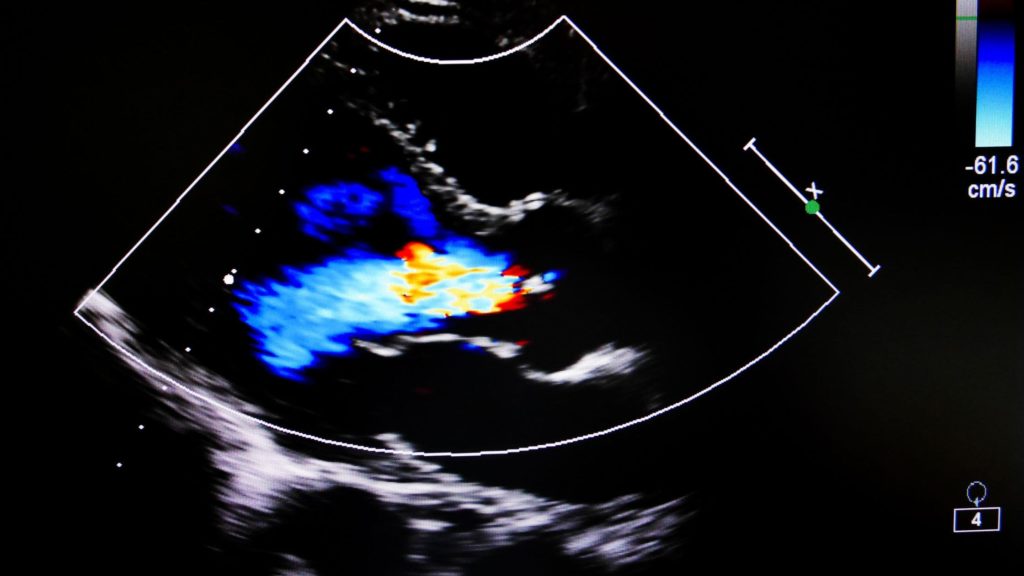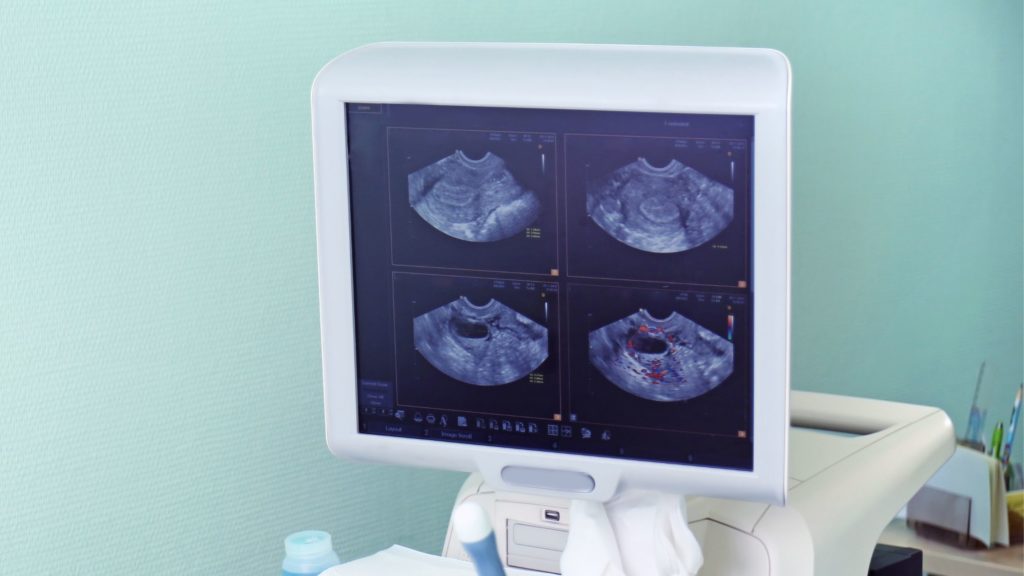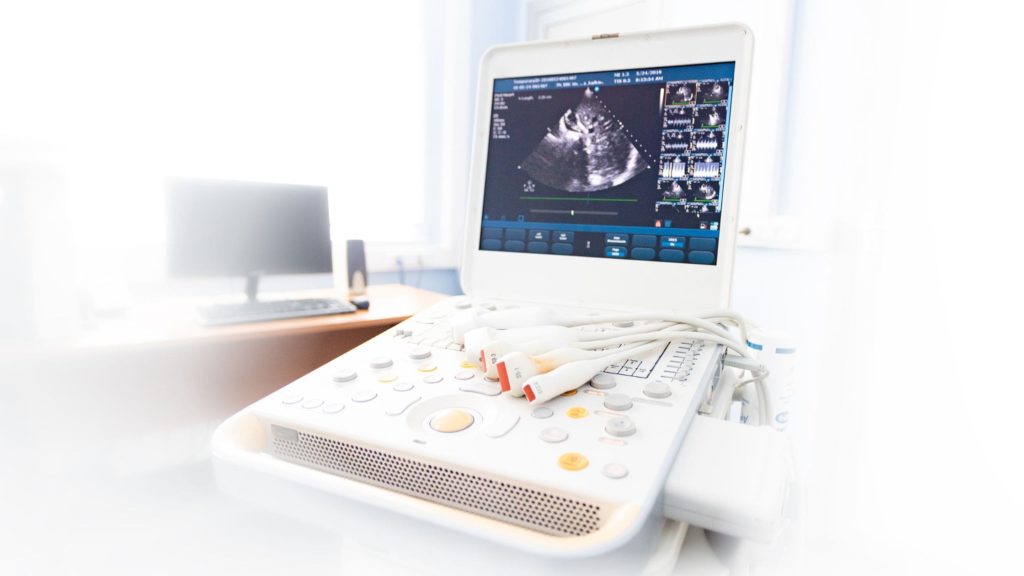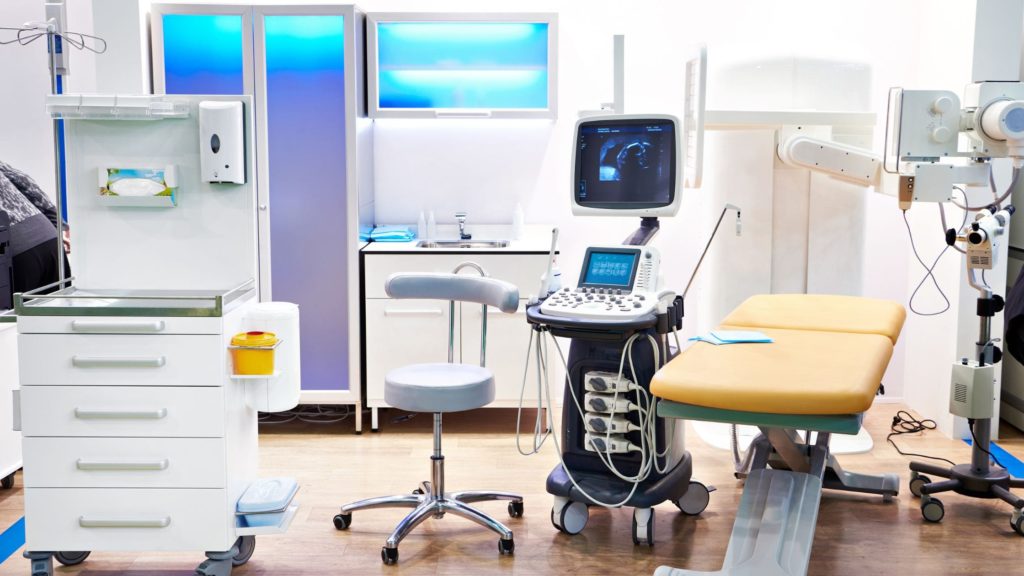Whether looking for a replacement for outdated ultrasound equipment or buying an ultrasound machine for the first time, choosing the right one is crucial.
The decision is not easy because there are so many different ultrasound machines to choose from and numerous factors for consideration.
So let’s explore what to look for when buying an ultrasound machine to help you make the best choice.
Purchasing an ultrasound machine is a significant investment, but ideally, you don’t want to pay more than necessary. While cost might be a key factor, there are numerous other considerations when looking for the best ultrasound machine. Let’s take a look at each in turn in our comprehensive ultrasound machine buying guide.
What are the Most Important Factors to Consider when Choosing an Ultrasound Machine?
Imaging Mode
The imaging mode is how ultrasound information is presented to the machine operator. The image mode defines how the image is shown on the screen. Some of the most common types of ultrasound machines use the following image modes:
A-mode
This is by far the simplest type of ultrasound mode. There is no image. Instead, there is a one-dimensional representation of the reflected sound waves. This imaging mode is generally used if you need to measure distances.
B-mode (brightness)
Also known as 2B mode, the image displayed on the screen is a 2D representation of the body part being scanned. This type of imaging machine is used across a variety of disciplines.
M-mode
This type of imaging produces a sequence of successive images that allow the user to view and measure movement and its amplitude.
Real-Time Spatial Compound Imaging
This type of ultrasound equipment uses electronic beam steering of a transducer array to rapidly acquire sonographic information from several angles. It is commonly used for musculoskeletal examinations and breast ultrasounds.
Color Doppler Imaging
With this imaging mode, users can visualize and analyze the flow of blood, its direction, and vascularization. Color Doppler Imaging is often used in cardiology to help analyze heart conditions.
Elastography
Ultrasound equipment with this mode can measure tissue hardness and diagnose various diseases such as hepatic fibrosis.
3D / 4D (Real-Time 3D)
This type of ultrasound machine is typically used to examine pregnant women. It provides a three-dimensional image of the woman’s fetus and allows doctors to check movements in utero.
Size
Ultrasound scanners come in a range of different sizes. Some of the best ultrasound machines are now portable if you need such a device.
Some hand-held models weigh little more than 500 grams. It’s easy to store such an ultrasound device in your pocket or a bag. Some are wireless, or you can connect them to your smartphone. Small, portable ultrasound equipment is very useful in emergency situations and point-of-care medicine.
Size of the screen
Size of the screen
The screen size is as important as the rest of the ultrasound machine. If you’re considering a portable ultrasound device, weigh up whether the size of the screen is sufficient for your needs, as the screen on a portable ultrasound machine tends to be much smaller.
Weight
As already mentioned, some portable ultrasound systems weigh less than a bag of sugar, and many such new ultrasound machines can easily be slipped into a pocket.
The larger the ultrasound machine, the more cumbersome it is. This isn’t an issue if you don’t need to move it around and it’s located in one space.
However, if you want an ultrasound machine that you can easily move around and take wherever it’s needed, the lighter and smaller, the better.
Quality of the image
More and more practitioners are looking for the best portable ultrasound systems. But despite major improvements in the imaging capabilities of the best portable ultrasound machines, a console-based ultrasound machine is likely to offer more effective imaging with better resolution, advanced functionality, and capabilities.
Ultrasound technology allows some portable ultrasound machines to display as many as 250 shades of gray. In addition, some have color screens and improved image quality. However, it’s important to note that these advanced capabilities do not come as standard across all models of portable ultrasound machines.
Brightness
In addition to color and the number of shades of gray, brightness is another factor that affects image quality. Veterinarians, for example, may need to use their ultrasound machines outdoors. Ideally, you want the brightness to be adjustable without experiencing any compromise in the quality of the image and your ability to read the results.
Types and number of transducers
A transducer or probe is an essential part of the ultrasound imaging process. You can purchase transducers in a range of sizes and shapes, with a diverse array of features, depending on the body parts you want to examine.
Ultrasound probes can be inserted into the body or passed over the skin’s surface. Probes and transducers differ in terms of design, and there are four basic types frequently used:
- Linear probes: Also known as vascular probes, linear transducers are for imaging superficial structures, vascular examinations, thyroid, breast, orthopedics, and other small parts, and measuring body fat.
- Curvilinear or convex probes: These probes have a wider footprint and operate at a lower frequency. They are often used for transabdominal imaging to achieve a wider field of view. This type of transducer is used in the diagnosis of organs, and abdominal examinations undertaken in obstetrics, gynecology, and urology. Micro-convex probes are another option. Their smaller footprint makes them ideal for pediatrics and neonatal applications.
- Phased array probes: This type of transducer is low frequency and has a small footprint. You would use a phased array transducer to obtain images between ribs, brain, abdominal and transesophageal examinations, and cardiac ultrasound exams.
- Endocavitary probes: These include transrectal, transvaginal, and transesophageal transducers. Their footprint is small because they are inserted via various cavities to examine organs more closely.
In addition, there are also 3D and 4D ultrasound probes that allow the user to analyze more detailed imaging. 3D probes allow users to view static 3D images, while 4D ultrasound allows live streaming video images.
Software Required
The software installed can enhance the diagnostic capabilities of ultrasound machines. Enhancements include Doppler studies, 3D/4D, Speckle reduction imaging, Auto IMT for vascular, elastography, spatial compound imaging, and many more.
The software can also improve image quality significantly and might include analytical tools to help the user identify patterns within the image or improve the accuracy of the diagnosis.
In addition, you also need to make sure that the ultrasound machine’s software is compatible with the software and hardware you currently use. Software support is another essential element you should consider.
Battery Life
Another parameter to consider is the life of the battery. This is especially important if you’re looking to purchase a hand-held or portable ultrasound machine. For such devices, you want a battery that will last several hours.
If you think you may have issues with interruptions to the power supply, battery duration and backup are important parameters to check out before you purchase an ultrasound machine. You should also look at the option of having a second battery if you’re purchasing a portable ultrasound system rather than a static one.
Purpose
How you plan to use your ultrasound system is a significant factor to bear in mind. Factoring in the intended usage of your ultrasound system will also help narrow down your options. In addition, it will ensure you’re not overspending or wasting resources on new or refurbished medical equipment that is too advanced for your practice.
Ultrasound systems can be used for various imaging applications, from obstetrics and gynecology to abdominal studies and imaging of other small parts. Here are some other diagnostic or screening uses you might have to consider:
- Obstetrics: Ultrasound systems are used during pregnancy. The progress of a fetus can be monitored, how many fetuses there are in the womb, the age of the fetus, the placenta’s location, fetal position, movement, heart, and breathing. A Doppler ultrasound can also measure blood flow and can be used if there are concerns about the growth of the fetus.
- Gynecology: A range of other women’s health-related issues can be detected using an ultrasound system. Examples include ovarian growths or tumors, ovarian cysts, uterine growths, abdominal pain, endometriosis, uterine fibroids, and much more.
- Cardiology: Echocardiography can evaluate the overall functioning of the heart. Ultrasound machines can indicate the volume and flow of blood through the chambers. Doppler ultrasound echocardiography is commonly performed to detect problems with heart valves.
- Blood vessels: Ultrasound machines can be very effective at detecting problems in the larger blood vessels of your body. Blood flow can be observed and measured. Narrowing or widening of blood vessels can be detected. Other ultrasound applications include detecting abdominal aortic aneurysms and blood clots in the veins, both superficial and deep vein thrombosis.
- Abdominal structures: Various organs within the abdominal cavity can be inspected using ultrasound machines.
- Testicular issues: Ultrasound systems can diagnose testicular torsion, testicular masses, growths, tumors, imaging of the breasts, and help find foreign bodies that may be lodged in the skin.
- Anesthesiology: Ultrasound machines are used worldwide in anesthesiology for diagnostic purposes and for carrying out various procedures.
When you’re looking to purchase an ultrasound machine, you have to know how you intend to use it. Usage will depend on the type of patients you treat and the cases you might refer to others because you don’t have the right ultrasound equipment.
It would be great if there was an ultrasound machine that did it all, but unfortunately, such a machine doesn’t exist. Even if it did, it would likely be far too expensive. Ultrasound machines are built with a specific use in mind, and each different one has its own strengths and weaknesses.
Price
The cost of an ultrasound machine can vary considerably. However, if you’re in the market for this type of system, there is usually one that will suit your budget or specialty.
There’s also the option of buying a refurbished ultrasound machine rather than a new one. Several factors can impact the cost of a new or refurbished ultrasound machine. They include:
- Brand and model: You can choose low or high-tier ultrasound systems. High-tier and more well-known brands tend to be more expensive.
- Functionality: Compared with a static unit, portable ultrasound machines are less expensive.
- Age: As you might expect, a new machine will cost more than a refurbished model. Older refurbished systems are also lower in price.
- Applications: The more applications the ultrasound system can perform, the higher the price.
Low-tier ultrasound systems start at around $5,000 and go up to $10,000. For a mid- to high-range model, you could pay upward of $200,000. On the other hand, a refurbished ultrasound machine ranges from $5,000 to $40,000 for an average model.
Power Output
Power output is an important consideration. In general, look for a machine with lower power settings, as it will be less likely to burn the epidermis or tissues.
Frequency
An ultrasound machine’s frequency relates to how deep the ultrasound waves will penetrate. In general, the higher the frequency, for example, 10-16 MHz, the more superficial image it will produce. High-frequency sound waves are better for musculoskeletal examinations such as the hand or foot.
The penetration is much deeper at a lower frequency, for example, 1 or 2 MHz. Low frequencies are better suited for abdominal scans.
Portability
You have to decide whether a portable ultrasound machine will be the right choice compared with a stationary console.
To help you decide, consider whether you’ll need to move the ultrasound machine around. A portable ultrasound machine will be better if you want to move it from one location to another. Static ultrasound machines are cumbersome to move around and could get damaged.
A portable ultrasound does have its limitations in terms of image quality, probe options, limited software features, and a small keyboard and monitor.
Hand-held ultrasound machines are ultra-portable but have been developed for the diagnosis of cardiology emergencies or other uses in emergency departments. They are not really intended for musculoskeletal use as this aspect of their performance is quite poor.
Brand
It is often best to buy ultrasound machines with a reputable brand name, such as Sinosite, Philips, Edan, Toshiba, GE, Mindray Ultrasound, or Sonoscape. These companies have been in business for several years and offer excellent customer service and a range of advanced models.
Level of training required to use the machine
Before you purchase, consider the skill levels of the technicians who will use the new ultrasound machine. Additional training may be required in order for the equipment to be used properly.
It might be worth asking whether the ultrasound machine provider provides offline or online training. On-site training might also be an option, but there will be an added cost.
Warranty duration, service contracts, and technical support
When buying your next ultrasound scanner, check the duration of the manufacturer’s warranty. It tends to vary from one manufacturer to another. Once the warranty has expired, there is also the issue of service conditions and contract terms to consider. Things to check include:
- Service contract duration
- Auto-renewal clauses
- Cancellation fees
- Guaranteed response times
- Preventive maintenance
- Parts
- Costs
Technical support is another aspect of your purchase that you shouldn’t forget. While making your purchase, take the time to negotiate alternatives to system updates and technical support. These are often bundled into the terms and conditions, so you want to ensure you get the best deal.
Availability of spare parts and accessories
There may come a time when you need to purchase parts or consumables for your new ultrasound machine. Are they difficult to get or too expensive?
Ideally, you want an ultrasound machine with readily available parts such as monitors, power suppliers, keyboards, upper control panels, panels, buttons, and keys.
Condition
One final thing to decide is whether you should opt for a refurbished or new ultrasound system.
A new ultrasound machine will come with a warranty, so you’ve got to weigh up the trade-off between reliability and price.
If you want a top-of-the-range model without investing too much, try buying a refurbished ultrasound machine. A refurbished system is a used machine that has been restored or upgraded. Generally, they are at massively discounted prices compared to new machines.
It’s best to approach a reputable supplier of refurbished ultrasound machines, such as Ultrasound Solutions Corp, an ISO 13485:2016 certified, FDA-registered company with more than 20 years of experience in the diagnostic ultrasound equipment industry. It has many happy customers, from hospitals and private practices to imaging centers and educational institutions.
Other features & parameters
There are several other features you should consider, including:
- Image storage capacity
- Ease of image transfer
- Integration
- Integrated gel warmer
- Connectivity with other peripheral devices
- Printer capabilities
Conclusion
Now that we’ve answered the question: what should I look for when buying an ultrasound machine? – you know how to find the best machine for your needs and make a wise investment.
Your time and effort in researching suitable ultrasound equipment will help reduce the final cost. Plus, it will ensure you find the best portable ultrasound machines or stationary machines on the market.












